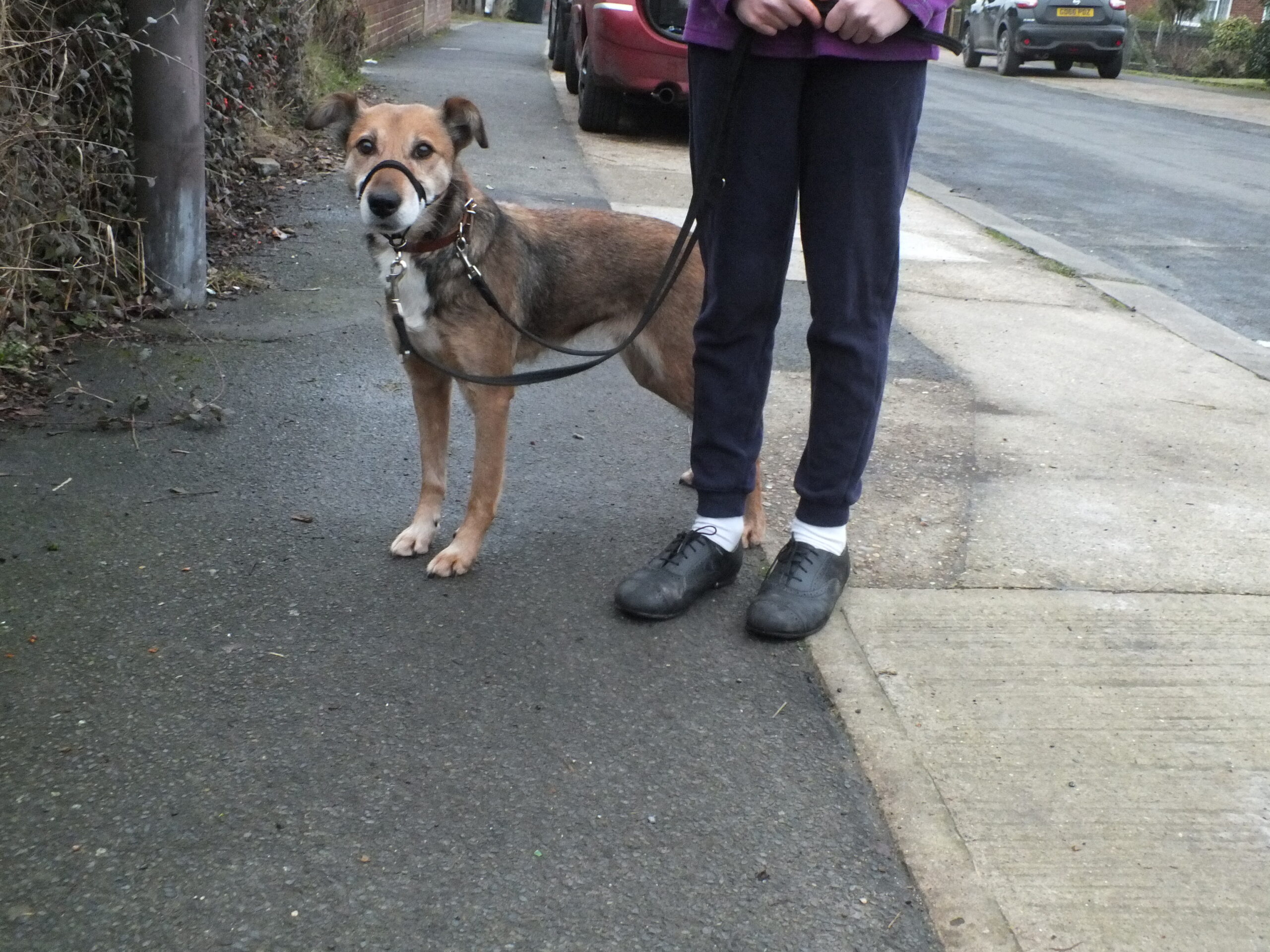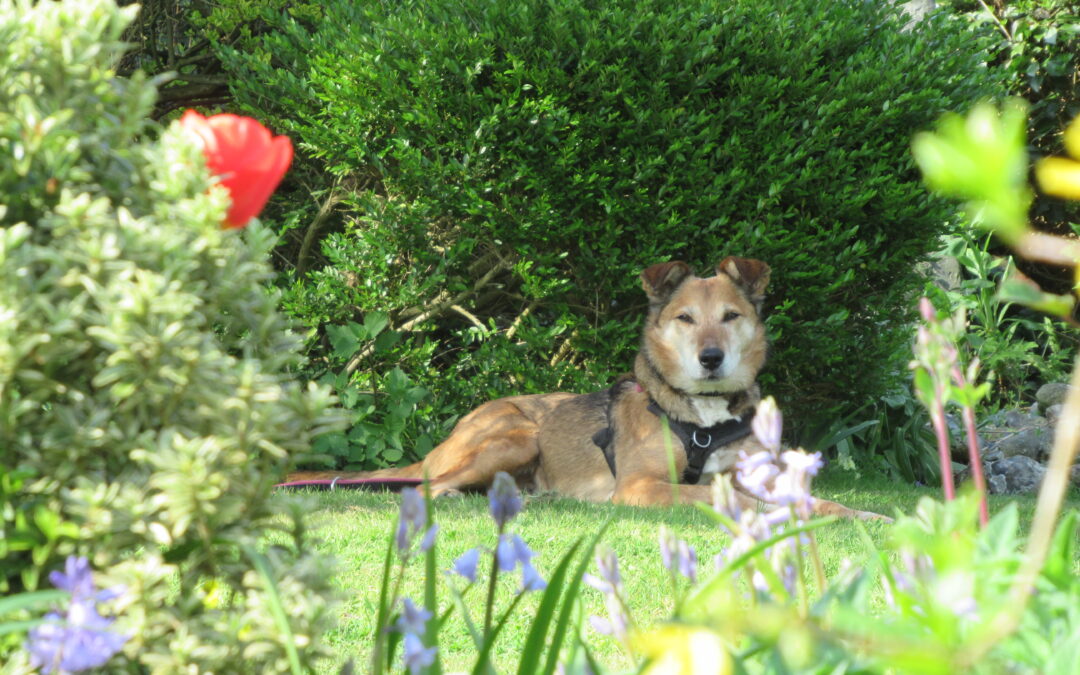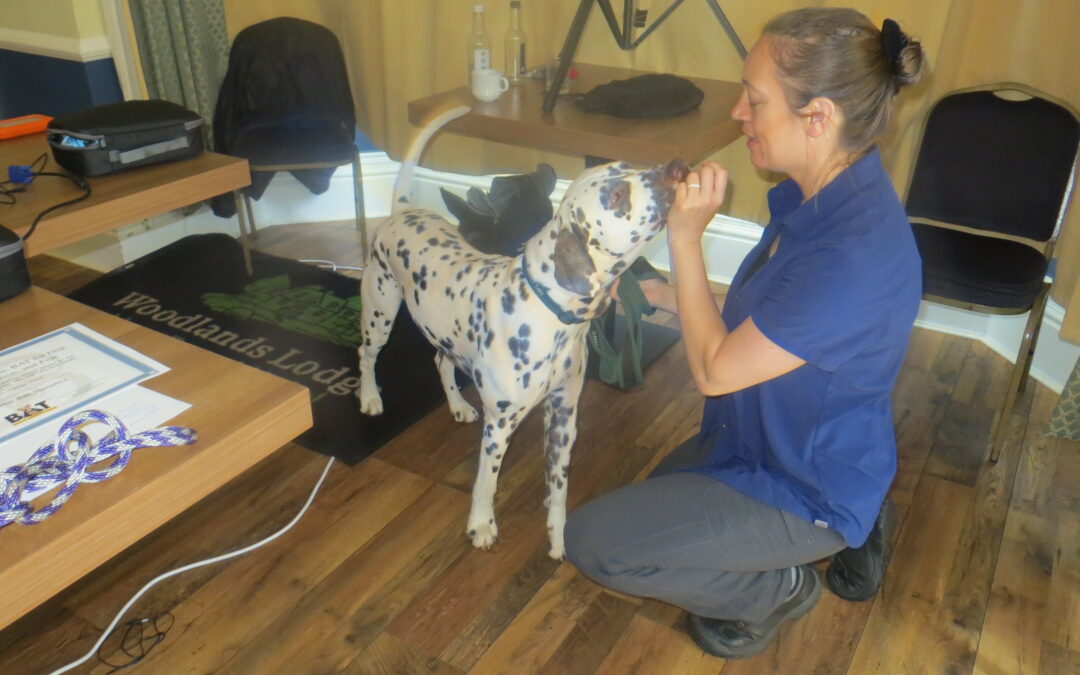Dog Headcollars

There are many different brands of dog headcollars out there. They sit snug to the dogs head giving you control over the direction and speed of which your dog moves. Traditionally used to give control over horses and cattle, they are often used as an anti-pull devise for pet dogs.
Dog headcollars : A Training Aid
Headcollars come into the category of ‘training aids’. A training aid should be used temporarily whilst training is taking place – it is there to aid training. It shouldn’t be used as a long term solution as a replacement for training.
However, there is more to consider when using a dog headcollar than just buying one, putting it on and then taking a walk with a perfect pooch.
A careful introduction required
Most dogs need carefully introducing to the headcollar before they are comfortable wearing one. The sensation of the material around their head, combined with the lack of control, can cause many dogs to roll around on the floor or paw at their face in an attempt to get it off. Some will even cause physical damage to themselves.
There are lots of videos on Youtube on how to introduce a headcollar using positive reinforcement. Pairing it with a treat so the dog accepts wearing it.
Calm or shut down?
Some report that the headcollar has calming effects too. While this is certainly going to be a plus point for many pet owners, I fear the reason behind this is actually damaging to the dogs mental state.
The dogs body language often reveals what is really going on. Watch a happy, bouncy, energetic dog go to one that is still with their tail lowered, head down and lack of interest in the environment and you will realise that ‘calming’ may be the wrong word to use. Suppressed, or shut down may be more appropriate as the dog realises he has no longer got any choice over what direction he moves in and general loss of control. Whilst this may not happen to all dogs, Ive seen there subtle behaviour changes that are often missed in many when a head collar is put on.
A walk is more than just exercise
Going for a walk should be more than just getting your dog to move their legs for exercise. Watch a dog move freely and you will see how they take in the sights, sounds and smells of what is going on around them. With the Covid-lock downs many people have suffered due to the lack of interaction with the outside world. This interaction is important for dogs too.
I would consider preventing a dog from sniffing, stopping to check out something moving in the distance and having a degree of control over their movement cruel. A headcollar can take away this freedom.
Be mindful of your actions
You can use a headcollar and still give the dog some freedom if you are mindful of your handling skills. Mindlessly pulling on the lead to dictate the dogs movement is a sure way for them to shut down. Avoid sudden yanks on the lead attached to the headcollar. These are unpredictable for the dog and can lead to anxiety as well as potential neck problems. Imagine sudden pulls on a devise that is attached to your head at times you don’t expect it. By the end of the walk you would probably end up with a sore neck from being pulled around as well as a fear of when and in which direction you would be pulled next.
By watching your dog you can usually predict their movements. Work with your dog and considering this you can also prevent your dog from shutting down as I mentioned earlier.
Combining equipment and training
If I am working with a dog that is strong enough to need a headcollar, I combine it with a harness, verbal cues and a training plan. Ideally I use a double ended lead with a clip at each end, but two single leads work in the same way.
Two types of Leadwork
I train two different types of leadwork to my own dogs as well as to my clients pets. Leisure Mode is where the dog is allowed to potter along and sniff. The dog and handler work together to ensure the lead stays slack. When the dog feels pressure on the lead, then they must stop. If the handler notices that the dog wants to stop and check something out then it is their duty to stop. I liken it to two friends going for a walk together, each aware of the others interests and pace. Leisure Mode is used for about 80% of on lead dog walks.
Training Mode is traditional lead work. Your dog walks by your side with their front legs level with your hips. The focus is on you rather than what is going on around them. This is hard for the dog and very unnatural for them. Training Mode is only used at particular times when this level of control is needed.
How to teach these two types of leadwork are outlined in my 21 Days to Loose Lead Dreams online course.
Only use a headcollar when essential
I only use a headcollar if it is essential for the safety of the dog and owner. You cant risk a owner being pulled into the road, or a dog hit by a car. I still use a harness as a primary attachment for the lead. However, I also have the dog wearing a headcollar attached to a second lead. This headcollar has been carefully introduced using them methods at the beginning of the article to minimise discomfort.
Some might say a harness should also be considered a training aid, but the lead has to be attached to your dog somewhere. I find a body harness that fits well, doesn’t tighten and is comfortable for the dog is the least intrusive place to attach a lead. Walking a dog on a collar feels wrong. A dogs neck is made up in the same way as our own. When walking a toddler on reins, the child wears a ‘harness’. You wouldn’t dream of attaching anything to their neck.
I walk in Leisure Mode using the lead attached to the harness as my first point of contact. Whilst doing this I aim to keep the lead attached to the headcollar completely loose at all times. This is just my back up plan. At times when the dog is still learning the rules, and there is a potential safety issue, then I use the headcollar for extra control. Before putting any pressure on the lead attached to the headcollar I also add in a word such as ‘steady’ so the dog knows what to expect.
Once the dog has learnt the rules of Leisure Mode, then the headcollar should no longer be needed. Even the largest, strongest, dog can be controlled with light pressure on a harness.
In conclusion on Dog Headcollars
So in conclusion, dog headcollars should only be used with careful consideration. They are there to aid training for strong dogs and need to be carefully introduced. A headcollar isn’t something you should just put on and use as a shortcut to proper training. Often with dogs, the behaviour your perceive your dog is displaying (i.e. calmness) is very different to what is actually going on (i.e. the dog is shut down). When using a headcollar, you need to be mindful of your dogs movement and avoid erratic pressure which can cause mental and physical damage.
21 Days to Loose Lead Dreams
Are walks a nighmare?
Feel like one arm is longer than the other?
21 days to loose lead dreams is a step by step plan to help make walks a pleasure again.
Stop The Pull – a introduction to loose lead walking
Stop the Pull An introduction to loose lead walkingThis month (and into February) on my social media I will be focusing on loose lead walking. Please check me out on twitter, Instagram, YouTube and Facebook - Dog Owner Training School.This important skill can make all...

Leaving the house on a loose lead
Leaving the house on a loose leadStop the pull before it starts! The daily walk is the highlight of the day for most dogs. This leads to your dog getting over excited and behaving like a sugar fuelled child at a birthday party. This over the top behaviour starts as...
What is a soft crate, and why do I need one?
What is a soft crate, and why do I need one?So what is a soft crate and why do I need one? So in the live on Monday, I discussed soft crates and why they are a piece of equipment I would be lost without. A soft crate is a bit like a portable tent for your dog. It is...

Accessing DOTS online courses
Accessing DOTS online courses I have put together the following videos as a guide to accessing the DOTS online courses. Signing up to a new course Accessing course materials once registered If you have any further questions please don't hesitate to contact...

Give your reactive dog a break
Give your reactive dog a break You have probably been told that dogs require a minimum of 1 walk a day. If you fail to give your dog this daily exercise then you are not undertaking your duties as a responsible dog owner. However this isn't always the case,...

My Inspiration: Grisha Stewart
Grisha Stewart Grisha Stewart Known for creating the BAT system, Grisha Stewart is a trainer who I highly admire. Behavioural Adjustment Training is for rehabilitating dogs who struggle with fear, frustration, or aggression. Grisha has written two books – Behavioural...
Free Facebook Group
Join our ‘Practical Puppy‘ group for lots of free resources and information
Get our newsletter
Sign up for our free newsletter to receive special offers, free training videos and the latest DOTS news
Got any questions?
We would love to hear from you!



